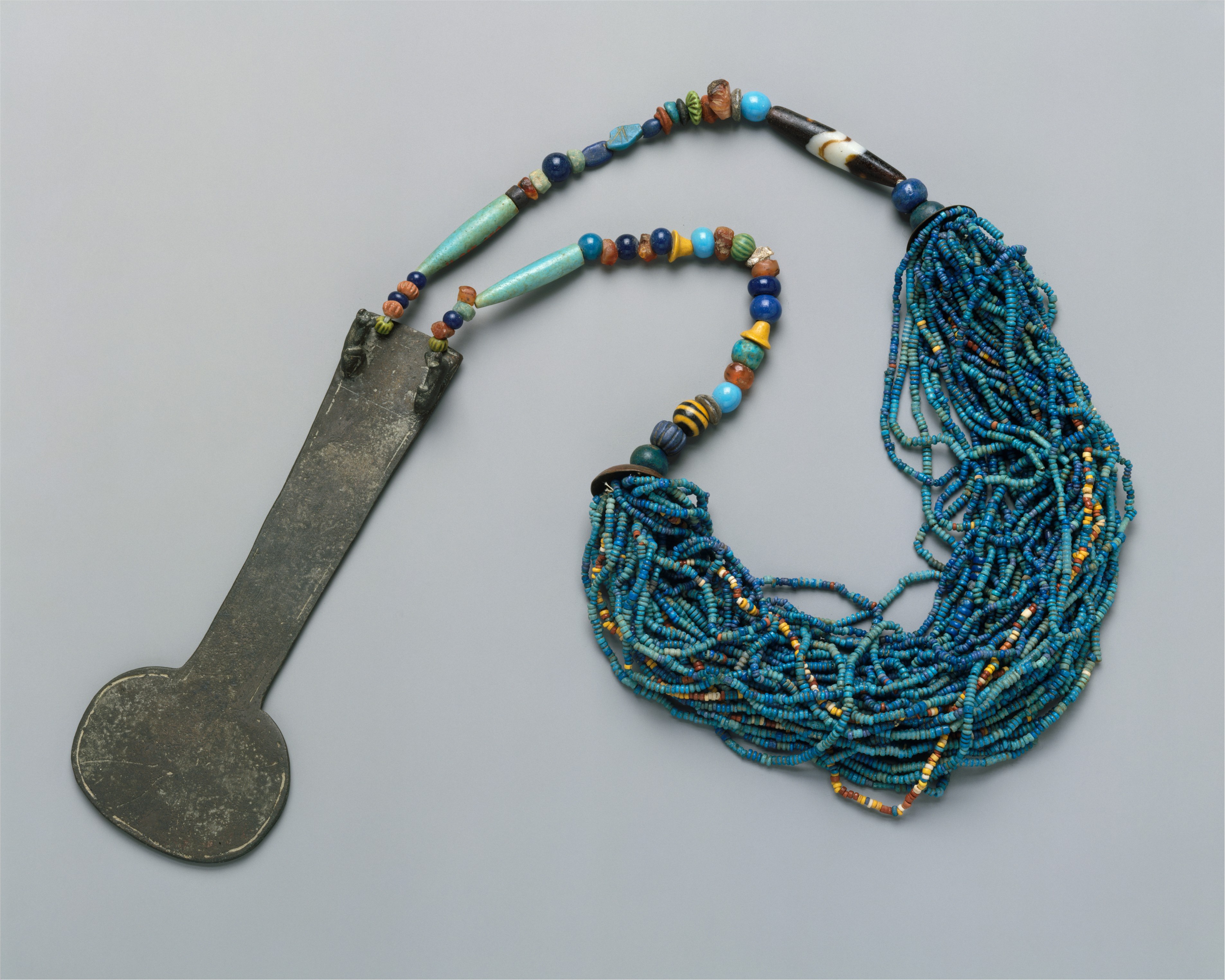Menat on:
[Wikipedia]
[Google]
[Amazon]

 In
In

ancient Egyptian religion
Ancient Egyptian religion was a complex system of polytheistic beliefs and rituals that formed an integral part of ancient Egyptian culture. It centered on the Egyptians' interactions with many deities believed to be present in, and in contro ...
, a menat ( egy, mnj.t, ar, منات) was a type of artefact closely associated with the goddess Hathor
Hathor ( egy, ḥwt-ḥr, lit=House of Horus, grc, Ἁθώρ , cop, ϩⲁⲑⲱⲣ, Meroitic: ) was a major goddess in ancient Egyptian religion who played a wide variety of roles. As a sky deity, she was the mother or consort of the sky ...
.
Operation
The menat was held in the hand by its counterpoise and used as a rattle by Hathor's priestesses. It was also worn as a protectiveamulet
An amulet, also known as a good luck charm or phylactery, is an object believed to confer protection upon its possessor. The word "amulet" comes from the Latin word amuletum, which Pliny's ''Natural History'' describes as "an object that protect ...
, particularly by Apis bulls.
Parts
The menat typically included anaegis
The aegis ( ; grc, αἰγίς ''aigís''), as stated in the ''Iliad'', is a device carried by Athena and Zeus, variously interpreted as an animal skin or a shield and sometimes featuring the head of a Gorgon. There may be a connection with a d ...
attached to beaded strings. The other ends of the strings were tied to a counterweight
A counterweight is a weight that, by applying an opposite force, provides balance and stability of a mechanical system. The purpose of a counterweight is to make lifting the load faster and more efficient, which saves energy and causes less we ...
that dangled on the wearer's back. The aegis was often made of faience
Faience or faïence (; ) is the general English language term for fine tin-glazed pottery. The invention of a white pottery glaze suitable for painted decoration, by the addition of an oxide of tin to the slip of a lead glaze, was a major ...
, but other materials such as leather
Leather is a strong, flexible and durable material obtained from the tanning, or chemical treatment, of animal skins and hides to prevent decay. The most common leathers come from cattle, sheep, goats, equine animals, buffalo, pigs and hog ...
and bronze
Bronze is an alloy consisting primarily of copper, commonly with about 12–12.5% tin and often with the addition of other metals (including aluminium, manganese, nickel, or zinc) and sometimes non-metals, such as phosphorus, or metalloids suc ...
were also used. It was often inscribed or bore depictions of deities associated with Hathor.
Purpose
The necklace was meant to ensure good luck and fortune and to protect against evil spirits. It was also worn for protection in theafterlife
The afterlife (also referred to as life after death) is a purported existence in which the essential part of an individual's identity or their stream of consciousness continues to live after the death of their physical body. The surviving es ...
and is often found buried with the dead, given as a grave gift since Ramesside times . It was expected to foster fruitfulness and good health for women, and for men it signified virility
Virility (from the Latin ''virilitas'', manhood or virility, derived from Latin ''vir'', man) refers to any of a wide range of masculine characteristics viewed positively. Virile means "marked by strength or force". Virility is commonly associ ...
.Doniger, ''op. cit.'', p. 709.
Footnotes
References
*Robert A. Armour, ''Gods and Myths of Ancient Egypt'', American Univ. in Cairo Press 2001 *George Hart, ''The Routledge Dictionary Of Egyptian Gods And Goddesses'', Routledge 2005 *Manfres Lurker, ''Lexikon der Götter und Symbole der alten Ägypter'', Scherz 1974 *Robert Steven Bianchi, ''Daily Life of the Nubians'', Greenwood Press 2004 *Wendy Doniger, ''Merriam-Webster's Encyclopedia of World Religions'', Merriam-Webster 1999 *Karel van der Toorn,Pieter Willem van der Horst Pieter Willem van der Horst (born 4 July 1946) is a scholar and university professor emeritus specializing in New Testament studies, Early Christian literature, and the Jewish and Hellenistic context of Early Christianity.
Education and career
Va ...
, Bob Becking, Wm. B. Eerdmans, ''Dictionary of Deities and Demons in the Bible'', Wm. B. Eerdmans Publishing 1999
*Erman, Johann Peter Adolf, and Hermann Grapow, eds. 1926–1953. Wörterbuch der aegyptischen Sprache im Auftrage der deutschen Akademien. 6 vols. Leipzig: J. C. Hinrichs’schen Buchhandlungen. (Reprinted Berlin: Akademie-Verlag GmbH, 1971).
External links
{{Ancient Egyptian religion footer, collapsed Egyptian artefact types Hathor Egyptian amulets